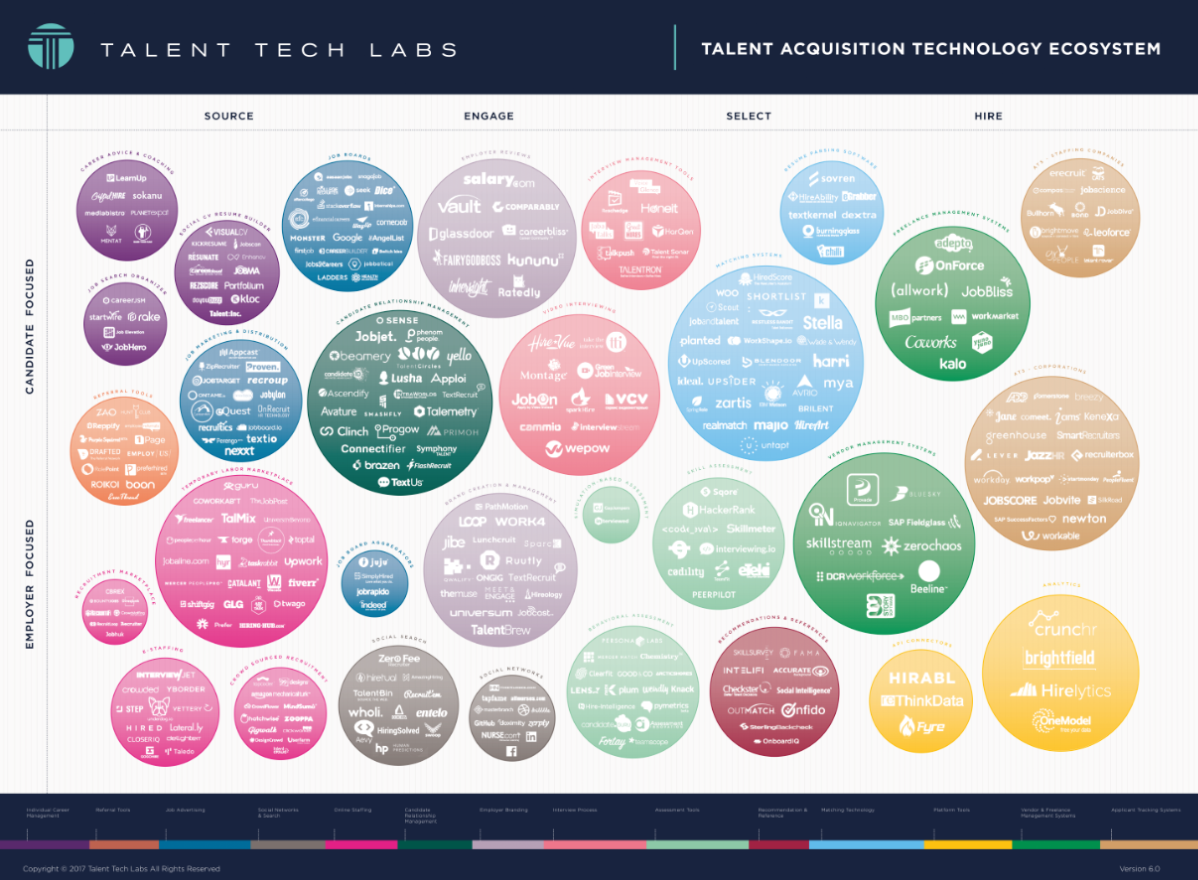Given the increased demand for compliance in recruiting, the growing pressure to hire top talent for organizations combined with the increase in dispersed teams, the need for recruiting software continues to grow. As an organization increases its headcount, business processes, tasks, and even planning become more complex. The recruiting process is no longer as simple as posting a “help wanted” ad in your business window. That’s where HR tech comes in, centralizing and organizing your efforts.
The folks at Talent Tech Labs have done a great job of providing a graphic that helps practitioners and providers alike understand the complexities of the recruiting technology landscape. The graphic continues to grow and evolve. The HR and recruiting software landscape is has grown X in the last X years because businesses are placing more importance on talent, whether it’s acquiring, retaining or developing. This renewed focus on talent means that leaders are willing to invest in recruiting and talent acquisition tech – and they have more options than ever before.
Related: Our guide to finding the right recruiting software for your business.
While recruiting talent for your organization sounds simple, it is in fact not. You can see that from the number of technologies listed and the types of recruiting software listed above. There are lots of nuances and complexities that can make recruiting and hiring a complicated and convoluted process. The complex nature of recruiting and hiring has led to the development of a number of different types of recruiting technologies and software.
However, all recruiting software isn’t equal. I don’t mean equal in terms of importance to the hiring process. I do mean, equal in terms of the role within the talent lifecycle they play.
Types of Recruiting Software
#1 – Source
This type of recruiting software is used to proactively search for talent. These include recruiting and resume databases, profile scrapers, org trees, and Chrome extensions designed to find information about candidates who may be the right fit for open requisitions within your organization. Sourcing software exists for recruiters looking for passive candidates who are not actively applying for jobs through career sites or job boards. Companies rely on this software to find and engage candidates before they begin the applying process.
#2 – Engage
Once candidates are sourced, recruiting teams need software to focus on the candidate as well as prospect communication. These include email, text message, phone calls and private messages. Sometimes engagement happens in the form of career and employee review sites providing candidates and prospects the tools, resources, and information they need to make the decision to apply for an open job, add your company to their short list, or join your talent community. The role and responsibility of these technologies are vast and also include employee-focused referral platforms and video interviewing technology.
#3 – Selection
Once your company has candidates who have expressed interest, selecting the right talent is critical to ensure that all this pre-work you’ve done doesn’t go to waste. Recruiting technology that falls into this category includes assessments, simulation technology, references, background checks and parsing software to help identify and support the hiring of the best talent for your organization.
#4 – Hire
Hiring is the most critical stage of the recruiting process because it is the end goal. But even before the candidate has accepted your offer, they must formally apply for the role with your applicant tracking system. It’s during this phase that different types of recruiting software overlap. Recruiters often interview a candidate as part of the selection process while simultaneously continuing to court and engage them for multiple roles. Hiring involves many moving parts in addition to your ATS including onboarding software and human resources information systems that play a role in successfully transitioning an applicant to employee.
#5 – HR Suite
Human Resource Technology Suites serve the purpose of supporting the HR and recruiting teams throughout the entire talent cycle from selection to hire to development to succession to transitioning to another team member. HR Suites are often strong in specific areas, such as employee development, payroll, or workplace compliance, but their suite of products serves a number of different functions which makes it extremely challenging for every module to be strong. Recruiting and HR teams add additional technologies and softwares into their stack to fully customize their specific department and business needs.
The Different Focuses of Recruiting Software
Different types of recruiting software help to alleviate roadblocks and bottlenecks in the hiring process. Recruiting software typically is either designed to engage one of two communities either candidates or employees. Sometimes recruiting technologies are designed for both audiences and their specific experiences. However, most technologies like sourcing are single dimensional. For sourcing technology, the recruiter experience is the most important. While traditionally ATS systems have been candidate-centered, there are companies like Comeet who are crossing the divide, introducing recruiting software that is designed to suit both the employee and the candidate and offering a more robust user experience for both parties.
I’m confident that as the recruiting and talent acquisition landscape continues to grow and evolve so too will our recruiting software and technology. It’s an exciting time to be recruiting but even more exciting to be in recruiting technology. The question for HR and recruiting leaders now is how do we navigate technological changes while also hiring, engaging and retaining our current and future talent better, faster, and with greater success than we ever have before.
Are you looking to start your hiring process today? Comeet can help.






























